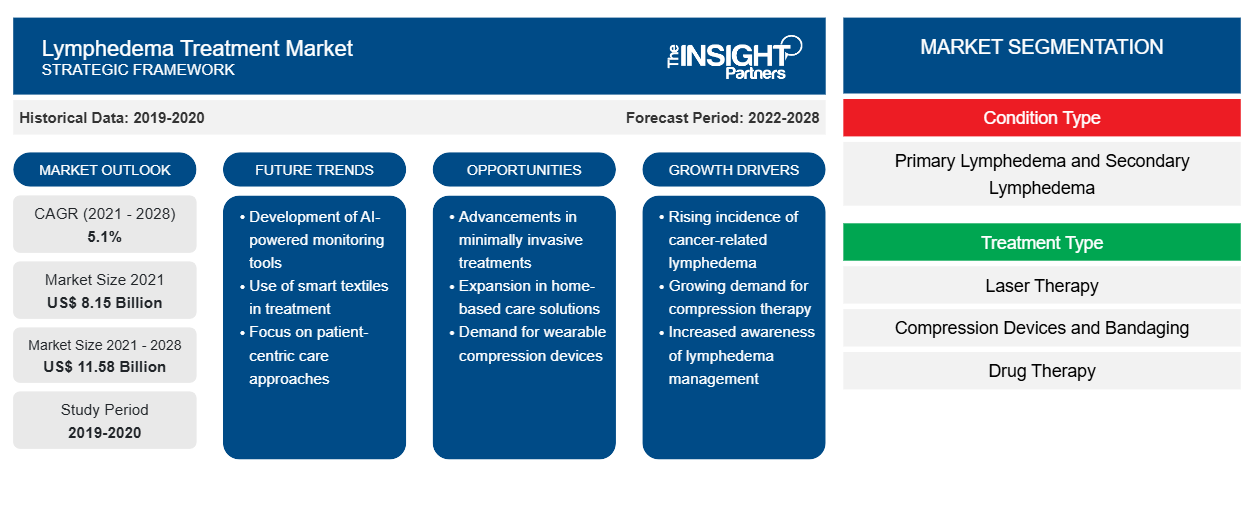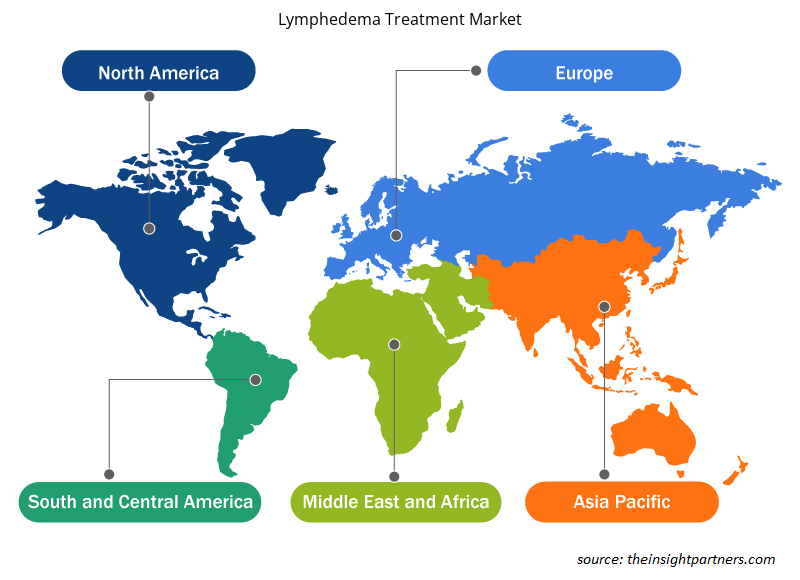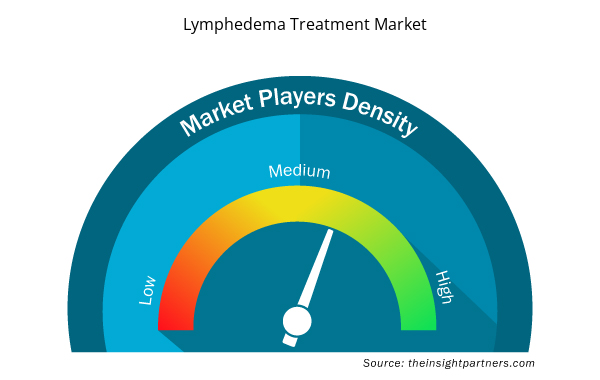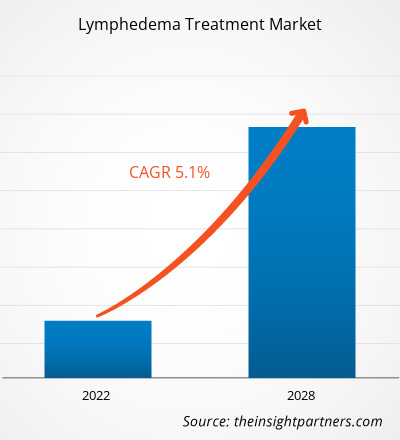The lymphedema treatment market is projected to reach US$ 11.58 billion by 2028 from US$ 8.15 billion in 2021; it is expected to grow at a CAGR of 5.1% from 2021 to 2028.
Lymphedema is a condition in which the body enlarges abnormally due to the lymphostasis caused by lymphatic system dysfunction. It most commonly affects the lower extremity (90%), upper extremity (10%), and genitalia (1%). Primary lymphedema is present at birth whereas secondary lymphedema is caused by lymphatic system inefficiency or damage. The secondary lymphedema frequently develops after cancer treatment. Lymphedema is caused by obstructions in the passage of lymph fluid caused by surgery, radiation therapy, or cancer growth. The feelings of tightness or heaviness; swelling in legs, arms, or other body parts; aching or discomfort; and fibrosis, which thickens or hardens the skin, are among the common symptoms of lymphedema.
Customize This Report To Suit Your Requirement
You will get customization on any report - free of charge - including parts of this report, or country-level analysis, Excel Data pack, as well as avail great offers and discounts for start-ups & universities
Lymphedema Treatment Market: Strategic Insights

- Get Top Key Market Trends of this report.This FREE sample will include data analysis, ranging from market trends to estimates and forecasts.
You will get customization on any report - free of charge - including parts of this report, or country-level analysis, Excel Data pack, as well as avail great offers and discounts for start-ups & universities
Lymphedema Treatment Market: Strategic Insights

- Get Top Key Market Trends of this report.This FREE sample will include data analysis, ranging from market trends to estimates and forecasts.
The growth of the lymphedema treatment market is attributed to the growing incidence of lymphedema and increasing number of lymphedema management programs with a surge in the promotion of telehealth services in various countries. However, the lack of skilled professionals and high surgical costs in developing economies hamper the market growth.
Market Insights
Rising Cases of Lymphedema
According to the United States Department of Health and Human Services, lymphedema can occur in cancer patients upon the onset of the disease or after its treatment, which affect lymph node drainage. For example, it has been reported that it can occur within days and up to 30 years after the treatment for breast cancer. Also, 80% of patients experience onset within 3 years of surgery, and the remainder develops edema at a rate of 1% per year. Additionally, a large patient pool, particularly women, suffers from lower-limb lymphedema after the treatment of gynecologic cancer, with the highest prevalence (37%) among vulvar cancer survivors and lowest prevalence (7%) among ovarian cancer survivors. Further, the overall incidence of arm lymphedema ranges from 8% to 56% at two years post-surgery. The Alliance Z 1071 longitudinal substudy of the American College of Surgeons Oncology Group (ACOSOG) states that in breast cancer trials, patients report a 3-year cumulative incidence of arm swelling and arm heaviness. Highly effective and advanced cancer treatment options assist in minimizing the risk of lymphedema. Therefore, major players in the cancer therapeutics market are highly focused on launching innovative products.
Condition Type - Based Insights
Based on condition type, the global lymphedema treatment market has been segmented into primary lymphedema and secondary lymphedema. The secondary lymphedema segment held a larger share of the market in 2021. However, the primary lymphedema segment is anticipated to register a higher CAGR in the market during the forecast period. The current market growth of the secondary lymphedema segment is attributed to the fact that cancer treatment is a prominent cause of secondary lymphedema, and majority of people suffering from secondary lymphedema are high in the developing and developed countries.
Treatment Type - Based Insights
Based on treatment type, the global lymphedema treatment market has been segmented into laser therapy, compression devices and bandaging, drug therapy, physiological procedures, debulking procedures, and others. The physiological procedures segment is further segmented into lymphovenous anastomosis (LVA) and vascularized lymph node transfer (VLNT). Further, the debulking procedures segment is subsegmented as surgical debulking, liposuction, and others. The compression devices and bandaging segment accounted for the largest market share in 2021. Companies in the lymphedema treatment market are developing different types of compression garments and are promoting cost-effective products. Further, the physiological procedure segment is anticipated to register the highest CAGR in the market during the forecast period.
Lymphedema Treatment Market Regional Insights
The regional trends and factors influencing the Lymphedema Treatment Market throughout the forecast period have been thoroughly explained by the analysts at Insight Partners. This section also discusses Lymphedema Treatment Market segments and geography across North America, Europe, Asia Pacific, Middle East and Africa, and South and Central America.

- Get the Regional Specific Data for Lymphedema Treatment Market
Lymphedema Treatment Market Report Scope
| Report Attribute | Details |
|---|---|
| Market size in 2021 | US$ 8.15 Billion |
| Market Size by 2028 | US$ 11.58 Billion |
| Global CAGR (2021 - 2028) | 5.1% |
| Historical Data | 2019-2020 |
| Forecast period | 2022-2028 |
| Segments Covered |
By Condition Type
|
| Regions and Countries Covered | North America
|
| Market leaders and key company profiles |
Lymphedema Treatment Market Players Density: Understanding Its Impact on Business Dynamics
The Lymphedema Treatment Market is growing rapidly, driven by increasing end-user demand due to factors such as evolving consumer preferences, technological advancements, and greater awareness of the product's benefits. As demand rises, businesses are expanding their offerings, innovating to meet consumer needs, and capitalizing on emerging trends, which further fuels market growth.
Market players density refers to the distribution of firms or companies operating within a particular market or industry. It indicates how many competitors (market players) are present in a given market space relative to its size or total market value.
Major Companies operating in the Lymphedema Treatment Market are:
- Biocompression Systems
- Essity Medical Solutions
- L & R Group
- SIGVARIS
- Tactile Medical
Disclaimer: The companies listed above are not ranked in any particular order.

- Get the Lymphedema Treatment Market top key players overview
End-User - Based Insights
Based on end-user, the global lymphedema treatment market has been segmented into hospitals, clinics, clinical research organizations (CROs), and others (ambulatory care centers and primary care centers). The hospitals segment captured the largest market share in 2021. The clinics segment is expected to register the highest CAGR during the forecast period; the market growth of this segment can be ascribed to the fact that lymphedema treatments are mostly offered in specialized centers or units. Specialized surgical treatments such as liposuction and debulking procedures take place in specialty clinics that have a dedicated department for neurology, or more specifically, lymphedema treatment.
Product launches and approvals are commonly adopted strategies by companies in the lymphedema treatment market to expand their global footprints and product portfolios. Moreover, the market players focus on the partnership strategy to expand their clientele, which, in turn, allows them to maintain their brand name worldwide.
Company Profiles
- BIOCOMPRESSION SYSTEMS
- Tactile Medical
- Smith & Nephew
- BSN medical GmbH
- Lohmann & Rauscher GmbH & Co. KG
- SIGVARIS GROUP
- ThermoTek
- Huntleigh Healthcare Limited
- 3M
- Mego Afek ltd
- Historical Analysis (2 Years), Base Year, Forecast (7 Years) with CAGR
- PEST and SWOT Analysis
- Market Size Value / Volume - Global, Regional, Country
- Industry and Competitive Landscape
- Excel Dataset


- Artificial Intelligence in Defense Market
- Wire Harness Market
- Unit Heater Market
- Health Economics and Outcome Research (HEOR) Services Market
- Joint Pain Injection Market
- Sandwich Panel Market
- Artwork Management Software Market
- Skin Graft Market
- Oxy-fuel Combustion Technology Market
- Medical Enzyme Technology Market

Report Coverage
Revenue forecast, Company Analysis, Industry landscape, Growth factors, and Trends

Segment Covered
Condition Type, Treatment Type, and End-User

Regional Scope
North America, Europe, Asia Pacific, Middle East & Africa, South & Central America

Country Scope
US, Canada, Mexico, UK, Germany, Spain, Italy, France, India, China, Japan, South Korea, Australia, UAE, Saudi Arabia, South Africa, Brazil, Argentina
Frequently Asked Questions
Who are the key players in the Lymphedema Treatment market?
BIOCOMPRESSION SYSTEMS; Tactile Medical; Smith and Nephew; BSN Medical GmbH; Lohmann & Rauscher GmbH & Co. KG; SIGVARIS GROUP; ThermoTek; Huntleigh Healthcare Limited; 3M; Mego Afek Ltd. are among the key companies operating in the lymphedema treatment market.
What will be the CAGR of Lymphedema Treatment market?
The market is estimated to grow with a CAGR of 5.1% from 2021 to 2028.
What are the driving factors for the Lymphedema Treatment market across the NA, EU, APAC, SCAM, and MEA regions?
Key factors that are driving the growth of the market are increasing incidences of lymphedema and programs conducted by the government fuel the growth of the market.
What is Lymphedema Treatment?
Lymphedema treatment mainly refers to the treatment options that are used in combatting primary and secondary lymphedema disease conditions. Some of the treatment types that are considered in the process include laser therapy, debulking procedures, liposuction, lymph node transfer, compression, and bandaging devices.
Trends and growth analysis reports related to Life Sciences : READ MORE..
The List of Companies - Lymphedema Treatment Market
- Biocompression Systems
- Essity Medical Solutions
- L & R Group
- SIGVARIS
- Tactile Medical
- SMITH + NEPHEW
- Thermo Tek
- Huntleigh Healthcare Limited.
- Physiopedia
- AIROS Medical, Inc.

 Get Free Sample For
Get Free Sample For